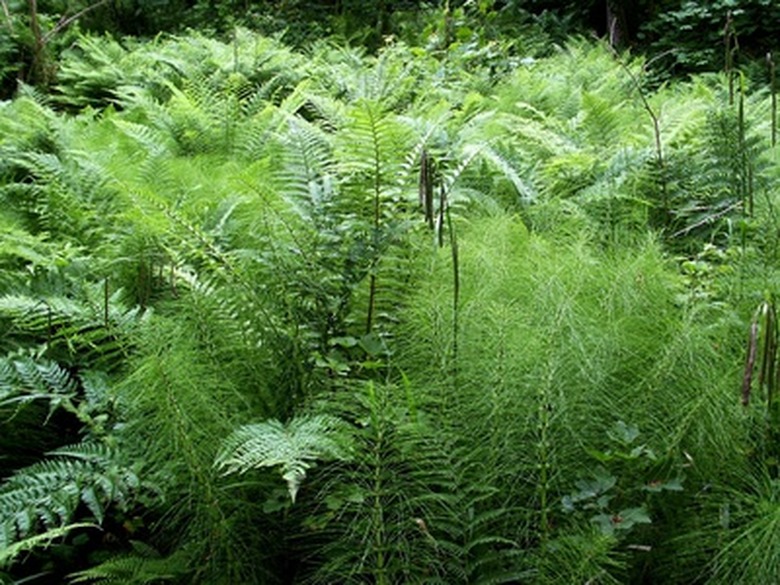How To Start An Asparagus Fern From A Sprig Or Berry
A graceful plant with shiny green, feathery foliage, asparagus fern (Asparagus densiflorus "Sprengeri") produces tiny white flowers in summer, followed by bright red berries in autumn. Each pea-sized berry contains up to three black seeds, which germinate easily to propagate a new asparagus plant. Gather the fresh seeds when the berries are plump and ripe in late summer or early autumn, then plant the seeds immediately. Although asparagus fern is usually grown indoors, it is suitable for planting outdoors in U.S. Department of Agriculture plant hardiness zones 9b through 11.
Step 1
Step 1
Gather berries from a healthy asparagus fern when the berries are plump and ripe in late summer or early autumn. To remove the seeds, place the berries in a piece of cheesecloth or muslin, then twist the fabric around the berries. Hold the fabric-wrapped berries under cool running water, squeezing gently until the water runs clear. Open the fabric and remove the seeds from the mashed pulp.
- A graceful plant with shiny green, feathery foliage, asparagus fern (Asparagus densiflorus "Sprengeri") produces tiny white flowers in summer, followed by bright red berries in autumn.
- Each pea-sized berry contains up to three black seeds, which germinate easily to propagate a new asparagus plant.
Step 2
Step 2
Fill a peat pot to within 3/4 inch of the top with a lightweight, well-draining potting mixture. A good quality commercial potting mix is suitable, but adding a handful of coarse sand to the mix promotes drainage and helps to prevent rot.
Step 3
Step 3
Place the peat pot in a tray of water and allow water to soak through the drainage holes until the potting mixture is wet. Set the pot aside to drain until the mixture is evenly moist but not dripping.
Step 4
Step 4
Plant the two or three seeds in the moist potting mixture. Cover the seeds with potting mixture equal to approximately twice the width of the seeds.
Step 5
Step 5
Cover the peat pot with a plastic bag, then seal the bag securely with a rubber band. Alternatively, you can cut a clear plastic soda bottle in half and invert the top of the bottle over the pot. The plastic will keep the potting mix moist until the seeds germinate.
- Fill a peat pot to within 3/4 inch of the top with a lightweight, well-draining potting mixture.
- Place the peat pot in a tray of water and allow water to soak through the drainage holes until the potting mixture is wet.
Step 6
Step 6
Place the pot in indirect light. Asparagus fern seeds germinate best in temperatures between 65 and 75 degrees Fahrenheit. Open the plastic for a few minutes if you see heavy droplets of water inside the plastic or if you see mold growing on the potting mix.
Step 7
Step 7
Remove the plastic and move the pot into bright light such as a south-facing window as soon as the seeds germinate — usually about three to four weeks. If you don't have a bright window, place the pot under a fluorescent light or grow light for 14 to 16 hours per day, with the light 6 inches above the pot.
Step 8
Step 8
Water as needed to keep the potting mix moist. Never allow the soil to become dry but don't water excessively as the seeds will rot in soggy potting mix. Fertilize the asparagus fern about a week after the seeds germinate. Use a general-purpose, water-soluble fertilizer diluted to a rate of no more than 1/4 teaspoon per gallon of water.
- Place the pot in indirect light.
- Remove the plastic and move the pot into bright light such as a south-facing window as soon as the seeds germinate — usually about three to four weeks.
Step 9
Step 9
Thin the seedlings, leaving only plant in the peat pot when the seedlings have at least two sets of leaves. Transplant the asparagus fern into a regular pot when the roots crowd the peat pot. Limit the size of the first pot to about 4 inches because a large pot holds too much damp soil and may cause the young plant to rot. Gradually transplant the asparagus fern into larger pots as the plant grows.
Warning
Asparagus ferns produce sap that may causes skin irritations, including redness and blisters. Additionally, the berries are slightly toxic and may result in stomach upset.
Things Needed
- Cheesecloth or muslin
- Peat pot
- Commercial potting mix
- Coarse sand
- Plastic bag
- Rubber band
- Fluorescent light or grow light
- General-purpose, water-soluble fertilizer
- 4-inch pot
References
- University of Arkansas Division of Agriculture: Plant of the Week, Asparagus Fern
- North Carolina State University Extension: Asparagus densiflorus (Sprengeri Group)
- Wisconsin Master Gardener Program: Asparagus Fern, Asparagus Densiflorus
- The American Horticultural Society, Plant Propagation; Alan Toogood, ed.
- University of Missouri Extension: Starting Plants Indoors From Seeds
- The New Sunset Western Garden Book; Kathleen Norris Brenzel, ed.
